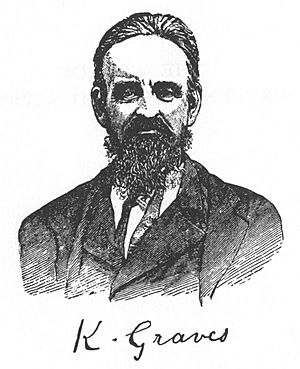Kersey Graves facts for kids
Quick facts for kids
Kersey Graves
|
|
|---|---|
 |
|
| Born | November 21, 1813 |
| Died | September 4, 1883 |
| Occupation | Rationalist, writer |
Kersey Graves (born November 21, 1813 – died September 4, 1883) was an American writer known for his ideas about religion. He was a skeptic, meaning he often questioned common beliefs, and a rationalist, someone who believes in using reason and logic. He was also interested in Spiritualism, which involves communicating with spirits, and was a reformist who wanted to change society for the better. Graves was quite popular among people who believed in freethought in the late 1800s. Freethought means forming your own opinions based on reason, not on tradition or authority.
The Early Life of Kersey Graves
Kersey Graves was born in Brownsville, Pennsylvania. His parents were Quakers, a Christian group known for their simple lifestyle and peaceful beliefs. As a young man, he followed their faith. Later, he joined the Hicksite Quakers, a group that focused more on individual spiritual experience.
Even though some sources say he only went to school for a few months, others suggest he had a good education. By age 19, he was already teaching in a school in Richmond, Indiana. He continued this teaching career for more than twenty years.
Graves and Social Change
Graves was a strong supporter of Abolitionism, the movement to end slavery in the United States. He was also interested in making language easier to understand. He joined a group of freethinkers within the Quaker community who wanted to make big changes.
In August 1844, he moved to Wayne County, Indiana, with about fifty other people who hoped to create a perfect community, often called a utopia. Around the same time, his Quaker group removed him because he wasn't attending meetings and had started his own rival group. The groups he was involved with later explored ideas like mesmerism (an early form of hypnosis) and Spiritualism.
In July 1845, Graves married Lydia Michiner, who was also a Quaker. They got married at Goschen Meeting House in Zanesfield, Ohio. They later had five children while living in Harveysburg, Ohio. After some time, they moved back to Richmond, Indiana, and bought a farm.
The Goschen Meeting House was a hub for a group called the Progressive Friends. They were involved in many important social movements of their time. These included supporting Temperance (reducing alcohol use), promoting peace, fighting against slavery, advocating for women's rights, and exploring socialistic ideas for a better society.
His Beliefs and Writings
Kersey Graves' Quaker background influenced his ideas. Quakers believe in the "Inner Light," which means everyone has a direct connection to God, making traditional clergy or church rules less important. The Hicksite Quakers, in particular, emphasized personal spiritual life over outward religious practices. The Congregational Friends, a group Graves was part of, went even further, moving away from traditional Christianity and even a belief in God.
Graves started his writing career believing that religion often twisted the truth. Over time, he began to claim that all religious beliefs were false and that the story of Jesus was a made-up tale.
His most famous book was The World's Sixteen Crucified Saviors: Or, Christianity Before Christ, published in 1875. In this book, he argued that stories similar to Jesus's life could be found in older religions. This book is still discussed by atheists and people who support the Christ myth theory today, even though many Bible scholars disagree with his ideas.
Other books he wrote include The Biography of Satan (1865), which explored the history of the devil, and The Bible of Bibles (1879), which discussed what he saw as errors in the Christian Bible.
Graves' ideas have been mentioned in other books, such as The Christ Conspiracy and Suns of God by Dorothy M. Murdock. His work might even have influenced popular novels like The Da Vinci Code. Tom Harpur used Graves' writings in his books about Jesus Christ in comparative mythology, and the famous atheist activist Madalyn Murray O'Hair also admired his work.
Kersey Graves passed away at his home near Richmond, Indiana, on September 4, 1883.
See also
- Christ myth theory
- Jesus Christ in comparative mythology

